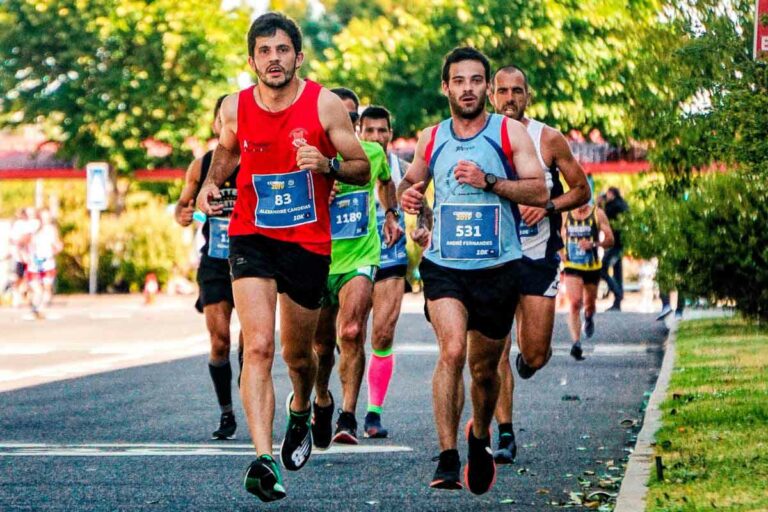How To Train For A 50K? How Long Should You Train?

So, you’ve signed up to complete your first 50K run. By this point, you should be a well-seasoned runner with various races and events under your belt.
However, if you’re used to running 25K and even marathon distances (42,195 km / 26.2 miles), and you’re EXPECTING to use the same training methods for a 50K, you might want to think again.
50K runs (31 miles) are far harder than they seem.
Trail and Ultra runners are far more than fit athletes – they train for hours every week to make sure their strength, core, speed, endurance, and mental ability are all up for the challenge.
Running a 50K is far more than simply RELYING on running skill alone.
Here is our guide on how to train for a 50K, otherwise known as an ultramarathon.
How Long Should You Train For A 50K?
As with any long-distance running event, the earlier you start training, the better. For a 50K, you’ll need to CALCULATE how long you trained for shorter distances and multiply that time accordingly.
The general rule for the bare minimum amount of training time for a 50K is at least 6 hours a week for 3 weeks. Of course, this is the absolute MINIMUM, so you’d want to ideally start sooner.
You should start this training at least 6 weeks before the event, so you can sporadically train within this time frame.
After all, training is never linear. You’ll have the inevitable ups and downs, work commitments, and the risk of injury – all of which will potentially get in the way of your precious training time.
It’s also not a one-size-fits-all situation. SEASONED marathoners might require far more or far less time to train than 6 hours a week for 3 weeks to complete a 5k.
Develop A Nutrition Plan
First and foremost, it’s time to develop a NUTRITION plan.
For 50k ultramarathons, you will benefit from working with a professional nutritionist to ensure you are eating the right foods for the training and the event.
The key to good nutrition for a 50K (along with any long-distance running event) is to stick to high protein and high carb foods to burn energy over long periods of time.
Training Routines
Now comes the fun part. Training for a 50K isn’t just about running long distances, you’ve got to incorporate different types of running training and other workout sessions into your routine for the best results.

Core Routine
Running up and down a mountain is a great way to push your body and running skills to their limits, so focusing on a core routine might seem pretty boring in comparison.
However, having a designated core day in the gym or at home will do wonders for your 50K training.
Having a STRONG core helps to keep your body ALIGNED while running It vastly improves and maintains your posture, and therefore keeps your body controlled and balanced while running.
This is essential for running on uneven terrain.
Core training also prepares your body for the impact of running UPHILL and downhill. Without a strengthened core, you won’t have the necessary support to drive your body up steep inclines.
The same goes for running downhill, as a strong core will help to prevent falling over.
Strength Training Routine
Strength training is equally important as endurance training, because you will be preparing your body to run properly in a range of terrains, inclines, and declines.
Without adequate strength training, and therefore preparing your muscles for hard impact, you run the RISK of damaging yourself.
Not only this, but strength training is essential for improving your endurance and stamina, as your body will learn how to properly STORE energy to prevent fatigue.
Plus, having physical strength will improve your mental strength, because you’ll know you can PUSH your body to complete the race.
You should implement a strength training routine in the gym (or in your home gym) to make the most of the equipment available.
It’s recommended that you follow a strict training guidelines or hire a personal trainer to tailor your training for the ultramarathon.
Jump Routine
If you don’t have access to mountains or a trail with steep inclines, you need to prepare yourself for the tough impact of off-road terrain with a proper jump routine.
Jump routines are more than simply jumping to heights and depths – it’s a methodical training routine that prepares your body for hard impact.
Not only does this work to protect your body from INJURY by teaching you how to land properly, but it also does wonders for strengthening your core and legs.
When To Implement These Routines
As any seasoned runner will know, you can’t just sporadically add a core session and strength session RANDOMLY into your training routine.
For the best results, you need to be methodical about when to complete these sessions.
The best time to implement either a core, strength, or jump session is on a day when you have an easy or moderate run.
You can either do the run before or after your chosen session. It is advisable to not implement one of these sessions on the day of a long or tough run, as this will lead to fatigue.
The key is to focus on quality rather than quantity. You’ll want to take your time with your training to get the best results, otherwise to risk burning out or injuring yourself before the event.
Also, you should only try to implement these sessions once a week into your routine.
This is because you need enough time to practice longer and tougher runs, and you also need to spare time in the week for rest days.
Without resting, you will render yourself useless.
If in doubt, it’s best to speak to a personal trainer or a previous ultramarathoner for their advice on how to train most effectively.
The Bottom Line
So, there you have it! Training for a 50K is far easier said than done. It requires a lot of systematic work to ensure you get the most out of your training.
After you tackle the 50K, you might be ready to proceed to your first 100K race or one of those toughest ultramarathon races in the world.






